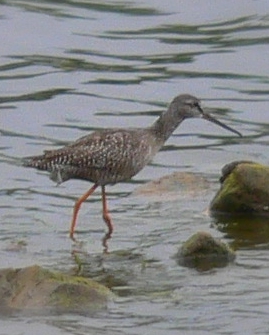- Spotted Redshank
Taxobox
name = Spotted Redshank
status = LC | status_system = IUCN3.1

image_width = 240px
image_caption = Juvenile Spotted Redshank
regnum =Animal ia
phylum = Chordata
classis = Aves
ordo =Charadriiformes
familia =Scolopacidae
genus = "Tringa "
species = "T. erythropus"
binomial = "Tringa erythropus"
binomial_authority = (Pallas, 1764)The Spotted Redshank "Tringa erythropus" is a
wader in the largebird family Scolopacidae, the typical waders. It is an Arctic bird, breeding across northernScandinavia and northernAsia . It is a migratory species, wintering around theMediterranean , the southernBritish Isles ,France , tropicalAfrica , and tropicalAsia , usually on fresh or brackish water. It is an occasional vagrant inAustralia andNorth America .It is 29-33 cm long. It is black in breeding plumage, and very pale in winter. It has a red legs and bill, and shows a white oval on the back in flight. Juveniles are grey-brown finely speckled white above, and have pale, finely barred underparts. It nests on open boggytaiga , laying four eggs in a ground scrape. The call is a creaking whistle "teu-it" (somewhat similar to the call of aRoseate Tern ), the alarm call a "kyip-kyip-kyip". Like most waders, it feed on small invertebrates.The Spotted Redshank is replaced as a breeding bird further south by the
Common Redshank , which has a shorter bill and legs, and is brown and white above with some dark patterning below, becoming somewhat lighter-toned in winter.Taxonomically, it forms a close-knit group with the
Greater Yellowlegs and theGreenshank , which among them show all the basic leg and foot colours of theshanks , demonstrating that this character isparaphyletic (Pereira & Baker, 2005). These three species are the largest shanks apart from theWillet , which is altogether more robustly built.The Spotted Redshank is one of the species to which the "Agreement on the Conservation of African-Eurasian Migratory Waterbirds" (
AEWA ) applies.References
* Database entry includes justification for why this species is of least concern
*Pereira, S. L., & Baker, A. J. (2005). Multiple Gene Evidence for Parallel Evolution and Retention of Ancestral Morphological States in the Shanks (Charadriiformes: Scolopacidae). "Condor" 107 (3): 514–526. DOI: 10.1650/0010-5422(2005)107 [0514:MGEFPE] 2.0.CO;2 [http://www.bioone.org/perlserv/?request=get-abstract&issn=0010-5422&volume=107&issue=03&page=0514 HTML abstract]Gallery
External Links
* [http://www.bsc-eoc.org/avibase/species.jsp?lang=EN&id=3CF7005EE4FE7679&ts=1220255243239&sec=summary Avibase]
Wikimedia Foundation. 2010.
